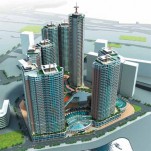Experience of Design-Basis Justification of Unique-Status Buildings and Structures

In continuation of the theme of the previous publication, this article provides a brief overview of a number of unique (high-rise and long span) structures and challenges of their design-basis justification, addressing modern methods and tools for numerical simulations developed by JSC Stadyo R&D and REC CM MGSU (Moscow State University of Civil Engineering).
Numerical simulation of wind flows, loads on framings and envelope building’s structures and parameters of pedestrian comfort.
As was noted in, developed, software-implemented and verified technique, based on the numerical solution of three-dimensional steady and unsteady fluid dynamics equations (Navier – Stokes equations with modern turbulence models), allows to determine the wind effects on tall buildings and complexes with the necessary correctness, reliability , completeness and urgency.
Numerical method and obtained on its basis results proved themselves in the scientific community as a rather reliable, and the research team - as the qualified one, that, in particular, allows passing the state expert appraisal of projects without wind tunnel simulations.
The list of the investigated structures in recent years include: highrise complexes “Aquamarine” (Vladivostok), “Gasoil City,” “Zodiac,” “Sky Fort”, “Dirigible”, “Rublevskie Ogny”, “Moscow-City” (Moscow) and “Pushkin” (Moscow reg.), as well as several other unique facilities (stadiums, sports palaces, trampolines and other sports facilities, train stations, bridges and NPP buildings).
The dimension of the resulting computational problems meanwhile reaches hundreds of millions of cells / unidentified, and the number of time steps in non-stationary problems – hundreds of thousands.
Stunning renderings and computer animations displaying the impact of wind flows and pressure distribution on framings and envelope building’s structure in pedestrian zones may well qualify for installations in museums of contemporary art.
It should be noted that confirmed by our research, “the universal” problem of aerodynamics computing modelsassisted design (and experimental wind tunnel as well): at very stable and precise definition of average components of wind loads, calculation methods of fluctuating parts require further research developments.
Full content of this issue you can read here
The full version of the article can be read in our printed issue, also you can subscribe to the web-version of the magazine
 TEXT: ALEXANDER BELOSTOTSKY, Director General of Stadyo R&D, the Head of REC CM MGSU Corr. RAASN,
TEXT: ALEXANDER BELOSTOTSKY, Director General of Stadyo R&D, the Head of REC CM MGSU Corr. RAASN,
Doctor of Technical Sciences, Professor


